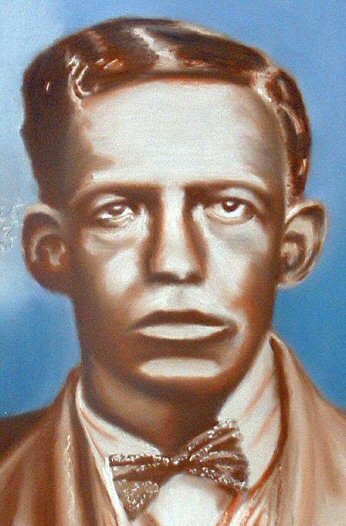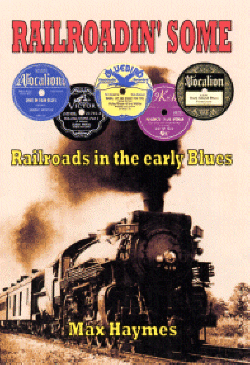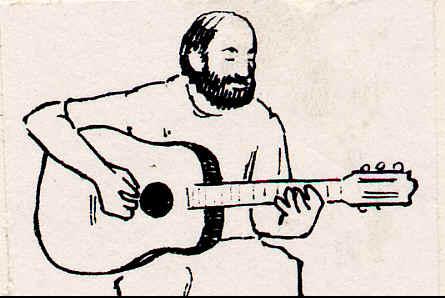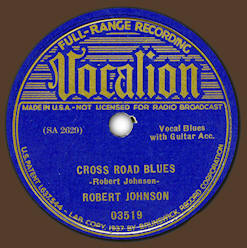 Robert
Johnson's Life Robert
Johnson's Life
Information on the events of Robert Johnson's
life is rather scarce. From birth
to his still-disputed burial place, his life has remained shrouded in mystery
for more than half a century. Indeed, some early blues researchers encountered a
difficult time finding any information about him, even in the years immediately
after his death. Historians weren't
even sure of the name of the man they were asking about. At various times in his
life, and also in different communities, Robert went by the names Dodds, Moore,
James, Barstow and Spencer, as well as that of his natural father, but never by
that of his mother (Major) or of her second husband (Willis).
Robert Johnson's mother was Julia Ann Majors,
whose parents had been born into slavery. In
1889, she married Charles Dodds, a carpenter and furniture maker, also the son
of former slaves. They owned their
land and their house and were comparatively fairly well off.
But, after narrowly avoiding the noose in Hazelhurst for injuring a
prominent white man in a fight, Charlie changed his last name from Dodds to
Spencer and fled to Memphis. Over the next couple of years Julia sent her ten children,
one by one, except for her two daughters, to stay with their father in Memphis.
While Charlie was there, he had taken a mistress and had two children by
her. Meanwhile, Julia had taken up
living with Noah Johnson, an itinerant sharecropper by whom she conceived
Robert. Robert Leroy Johnson was
born out of wedlock, on May 8, 1911, near the town of Hazelhurst, Mississippi.
For the first few years of Robert's life, he
lived with his mother moving from plantation to plantation.
In 1914, Julia took her family to Memphis where she, her ten children,
Charlie Dodds, his mistress, and their two children, apparently got on fairly
well together. However, Charlie resented young Robert, the outside child,
evidently already having discipline problems.
Julia disappeared not long after the family arrived in Memphis, returning
two years later to ask for Charlie's permission to remarry.
So when Robert was 4 or 5 years old, he went to live with his mother and
her second husband, Willie 'Dusty' Willis, in the shanty-town of Commerce, near
Robinsonville, Mississippi. Robert
showed no interest in farming, preferring to play music and trade songs with his
friends. In 1927, he got his first guitar.
In 1929, at the age of 18, Robert fell in love
with 16 year old Virginia Travis. They were married on 16th February, and the
young couple moved in with Robert's half-sister Carrie.
Robert then did more farm work than playing music.
In August, Virginia became pregnant. On 10th April 1930, both she and the
baby died in labour.
A few months after Virginia died the popular Son
House came to Robinsonville with Willie Brown.
Robert constantly badgered the older Son House, who tried to teach him
some guitar, but Robert showed little promise.
He would occasionally borrow a guitar when House or Brown were having a
break, driving the audience out of the juke joints with his inexperienced
playing. During late 1930 or early 1931, Robert went to Hazelhurst to search for
his father. This is the period of
his life when he reputedly disappeared to 'sell his soul to the devil'.
In Hazelhurst, he began taking guitar lessons from Ike Zinnerman.
Johnson was a reputed ladies' man to whom women
"were like motel or hotel rooms," in the words of Johnny Shines, who
frequently travelled with him. However, in May of 1931, during his stay in
Hazelhurst, he married Calletta "Callie" Craft, an affectionate woman,
twice married with three children. With Callie, Robert established a pattern
that he was to follow in the coming years wherever he went.
Seeking out older, often less attractive women, or a homely young girl,
for whom there would likely be no competition, he would exchange his attentions
for their kindness and a place to stay. One
researcher found at least half a dozen women who had relationships of this kind
with Robert, most of them lasting two or three weeks. Whilst many blues artists
got nothing but a meal or free booze for their work, Robert usually had a little
money too, which appealed to many local ladies.
There is little evidence that Robert Johnson had
any family. However, the blues
singer Robert 'Junior' Lockwood was said to be the son of one of Robert
Johnson's 'girl friends'. Also,
recent research has located Claude Johnson, reputed to be Robert's son, together
with grandson, Gregory and great-grandson Richard.
Described by David 'Honeyboy' Edwards, as tall
and skinny, Robert also had a bad eye, evidently due to a cataract.
There are only two surviving photographs of Robert, found years after his
death. In one of them he looks
young and sophisticated in a pinstripe suit, with a hat tilted at an angle.
In the other more informal picture, he looks relaxed with possible hints
of the sullen, more morose character which has become the Robert Johnson myth.
Studying the photographs it looks like his left eye was the bad one, but
not as bad as legend has led us to believe.
Robert, described as a sulky person, would disappear for weeks at a time,
giving no reason, even deserting fellow artists during a session. He was a very
widely travelled man, travelling around the Mississippi Delta, to Chicago,
Detroit, New York, Texas, Kentucky, Indiana, and even as far as Windsor,
Ontario, Canada, earning his living solely through music.
Musical Education
Robert's earliest musical desire was to be a
harmonica player, but that soon waned, and he decided he wanted to be a guitar
player like Son House and Willie Brown. Robert
would literally sit at their feet, studying their technique, arrangements and
styles, in the rowdy juke joints. In
Hazelhurst, Robert had apprenticed himself to Ike Zinnerman, a veteran guitarist
from Alabama. He often spend entire
weekends playing with Zinnerman, said to be an excellent guitarist, but
unfortunately one of the many unrecorded bluesmen.
Robert was reported to have one of the 'quickest
ears' in the Mississippi Delta. Johnny
Shines claimed he could have a conversation while listening to a song on the
radio playing it, note for note, hours or even days later. Shines also said, when playing for money on street corners,
Robert was just as likely to play a Bing Crosby tune, or a current jazz tune as
he was to play one of his own songs. Not
many people recall him ever practising or working out new songs.
Whenever he picked up the guitar with people around, it was to work. On
the subject of learning to play the guitar, Shines summed it up by saying 'They
don't talk about a duck learning to swim, do they?'. So it was for Robert
Johnson.
Songs and Music
During Robert's period of wandering as an
itinerant blues singer, he was heard by a local record salesman of the American
Record Corporation (ARC). He was recommended to ARC's Don Law, who had gone
South to record local artists for the Vocalion label. Robert recorded 29 songs
for Vocalion in five sessions, 16 of them in a makeshift studio in a room of the
Ganter Hotel, San Antonio, Texas, in November 1936, and the other 13 in a
warehouse in Dallas, Texas the following June. Only twelve of
these recordings were released during his lifetime. There is reference to
a thirtieth 'bawdy' song, recorded at the engineers' request, but this has never
been located. It has never been established which, if any, of his recordings
were specifically created for the studio, and what proportion were regularly
performed. Johnny Shines, reminiscencing about Robert's 'talking guitar
playing', is frequently quoted: "His guitar seemed to talk; repeat and say
words with him like no one else in the world could. One time in St Louis we were
playing one of the songs that Robert would like to play with someone once in a
while: 'Come On in My Kitchen'. He was playing very slow and passionately, and
when we had quit, I noticed no one was saying anything. Then I realised they
were crying - both men and women".
Most of Robert's songs can be traced to other
older and contemporary bluesmen, either heard personally or on record, like Son
House, Willie Brown, his great hero Lonnie Johnson, Hambone Willie Newbern,
Leroy Carr, Scrapper Blackwell, Tommy Johnson, Kokomo Arnold, Charley Patton,
Skip James, Big Bill Broonzy, and of course Ike Zinnerman. Any song Robert Johnson played automatically became his own.
Robert would pick up any hillbilly tune, popular song, ballad, 'sweet
music' from the radio, and convert them into his purely personal style.
The Legend of the Devil and
Robert Johnson
According to legend, in 1931 Robert disappeared
from Robinsonville, where he had been hanging around with Son House and Willie
Brown, and travelled to Hazelhurst. During
those months away, he studied guitar with Ike Zinnerman.
Ike claimed that he learned how to play guitar by sitting in a graveyard
on tombstones at night. When Robert
returned to Robinsonville, his playing had improved so incredibly that people
began to speculate that he had met the devil and swapped his soul for such
ungodly ability. Son House was
emphatic "he sold his soul to the devil to get to play like that." Certainly he didn't need any more lessons.
The awkward kid, who could barely play the harmonica and who had very
little command of the guitar, had been changed into a kind of master musician
who gained a great deal of respect.
In such a superstitious society as the
Mississippi Delta in the thirties, some of Robert's more peculiar traits might
have been seen as slightly demonic, for instance: the cataract in his eye, and
his practice of playing with his back turned to other musicians, usually into a
corner of the room, which some took as proof that he had something to hide,
whereas he probably wanted to get better sound, or even prevent other musicians
from stealing his style. LeDell
Johnson, the brother of Tommy
Johnson, another bluesman supposed to have entered into an unholy pact, says
that "if you go to where...a crossroads is... a big black man will walk up
there and take your guitar, and he'll tune it".
Many of Robert's lyrics are full of dark and demonic imagery.
Devils and demons fill his visions, as in his 'Me And The Devil Blues'
and 'Hellhound On My Trail'.
The idea that a performer is evil incarnate
evidently caught the interest of 1930s blues audiences.
The rumour that a man had the devil on his side probably amounted to a
form of protection against some of the unruly characters who assembled in the
roadhouses and juke joints in which bluesmen played. Many locals regarded such itinerant musicians as privileged,
relatively wealthy outsiders, interlopers wanting to steal their women.
The Death of Robert Johnson
Robert was acknowledged as a musical genius by
just about everybody who met him. However, he couldn't stand his own success,
and it has been said it was his downfall. Modern day rock stars turn to drugs to
handle the success and pressures success brings. Robert turned to women to give
him comfort. Unfortunately he turned to one too many.
On Friday, August 12th, 1938, Robert and David 'Honeyboy'
Edwards were booked to play at a dance in Three Forks, near Greenwood,
Mississippi. Robert was apparently
showing too much interest in somebody's wife or girlfriend.
The next night, the jealous husband had his friends give Robert some
poisoned whiskey. Another
eyewitness, Sonny Boy Williamson (Rice Miller), claims that Robert was openly
displaying affection for some particular lady, who was, indeed, the wife of
their employer. Sonny Boy claims
that a pint of whiskey was sent to Robert. He drank it, while Sonny Boy stood by
helplessly and watched. Honeyboy Edwards, who showed up after the poisoning, said
that around 1.00am, Robert became sick while playing, but the audience wanted
him to carry on. By 2.00am, he was
so ill they had to take him into Greenwood, but there was no money for a doctor.
Robert survived for several days, but finally died on Tuesday, August
16th, 1938.
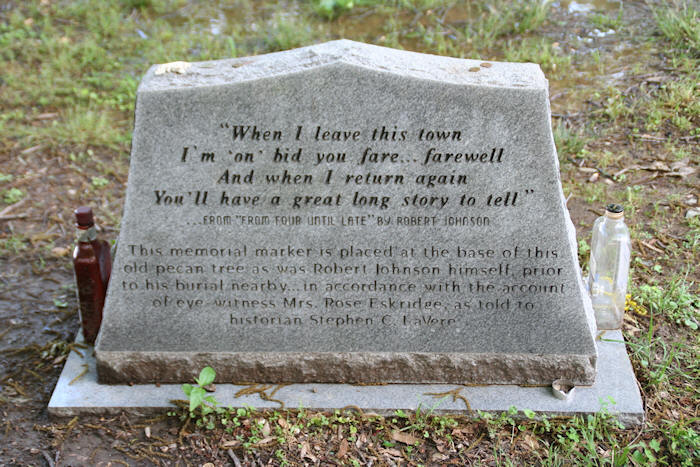
© Copyright 2008 Alan White. All Rights Reserved.
The Certificate of Death contains several
inconsistencies (e.g. age, date of birth), however the cause of death is
recorded as 'No Doctor'. No one was
ever brought to trial, although, researcher Robert Burton 'Mack' McCormick more
recently located a black man who confessed to the crime. Mack refuses to reveal
any more details of the man's identity, but suggested that he may do after the
man's death.
Whilst the legend claims that Robert howled like
a dog before he died (clearly alluding to the black arts), this is at odds with
a contemporary report from Honeyboy Edwards who said he died alone.
Robert
Johnson's Importance to Blues Music.
Robert Johnson is acknowledged as perhaps the
most accomplished and certainly the most influential of all bluesmen.
His style was easily adapted to a band setting with amplified
instruments; the bass line could be carried by piano, bass and drums, while the
electric guitar or harmonica took up the treble.
Versions of songs he recorded or which were associated with him have been
made by a wealth of contemporary blues singers, including:
Jimmy De Berry
Robert 'Junior' Lockwood
Eddie Boyd
Robert Nighthawk
Jimmy 'Maxwell Street' Davis
'Little' Junior Parker
Leroy 'Baby Face' Foster
Johnny Shines
Boyd Gilmore
Roosevelt Sykes
B. Hutto
Robert Henry'Baby Boy' Warren
Elmore James
Muddy Waters
Homesick James
Big Joe Williams
Bobo Jenkins
Sonny Boy Williamson (Rice Miller)
Johnny Littlejohn
Howlin' Wolf
More recent rock and blues singers/bands who have
also made versions are:
Paul Butterfield
Cream
Eric Clapton
The Rolling Stones
His importance as a blues player only became
apparent years after his death, through the growth and popularity of urban blues
and rock 'n' roll. Today, Robert's
presence can be felt behind many of our best singers. He has become an almost
legendary figure among white blues enthusiasts, especially in America and
somewhat surprisingly, here in Britain. I
believe the legend has been encouraged by more recent (1960's and 1970's)
interest in the 'roots' of rock music. The popularity of the Rolling Stones
version of 'Love In Vain', and Cream / Eric Clapton's 'Crossroads' are examples. Interestingly, the recent CD re-release of Robert's complete
recordings sold in excess of 325,000 copies between August 1990 and April 1991;
enough to be certified gold. In
contrast, Robert's first record "Terraplane Blues," recorded in 1936
and his only hit during his lifetime, sold just 4,000 copies.
It has been said the only modern guitarists with
a real feel for the blues, are Jimi Hendrix and Eric Clapton. The core of Jimi
Hendrix's playing was the blues, even if he himself was convinced of 'selling
out' to blatant commercialism. Comments have been made that Robert Johnson's
music 'has now become part of Eric Clapton'. Clapton states he has taken thirty
years 'meandering the back roads', only now 'getting there' in terms of making
'real' blues music. Perhaps we shall see more of Robert's influence on Clapton
in future.
For the past several years a 'blues revival' has
been taking shape. Even the U.S
Postal Service has recently issued a "Legends of American Music" set
of eight special issue stamps, honouring, among others, Robert Johnson, Muddy
Waters and Howling Wolf. Whilst new versions of the original blues classics will
no doubt continue to be made, and no doubt criticised for not being faithful to
the original, they will however play an important part in continuing the legacy
of the blues, repeatedly encouraging listeners to delve deeper into the roots of
the music, re-discovering and perpetuating the legacy of the original bluesmen.
Robert Johnson will be there amongst them.
Robert Johnson's music was the expression of a
solitary man. It was folk music
expertly played and sung, but it was also the intimate song of an individual,
sung with genius. It is the
autobiographical nature of the songs, their intense personal passion, reflecting
chaos and loneliness, executed so vibrantly that continues to capture the
imagination of listeners today. Despite
his influences, Robert Johnson's music is unique, and the mystery that continues
to surround him only reinforces his hold on our imaginations. He was indeed,
'King of the Delta Blues Singers'.
__________________________________________________________________________
BIBLIOGRAPHY
1 The Devil and Robert Johnson: The Blues and The 1990s
Author: Russell Banks
Publication: The New Republic
Date: 29th April 1991
2 Blues Walking Like A Man: The Complicated Legacy of Robert Johnson
Author:Francis Davis
Publication: The Atlantic
Date: April 1991
3 Eric Clapton: Lost in the Blues
Author:Eric Clapton
Publication: Guitar Player
Date: September 1993
4 Listen To The Blues
Author:Bruce Cook
Date: 1975
5 Mystery Train
Author: Greil Marcus
Publisher: Omnibus
Date: 1977
6 Love In Vain: A Vision of Robert Johnson
Author: Alan Greenberg
Publisher: Da Capo
Date: 1994
7 The Devil's Music: A History of The Blues
Author: Giles Oakley
Publisher: British Broadcasting Corporation
Date: 1976
8 The Guinness Who's Who of Blues
Editor: Colin Larkin
Publisher: Guinness
Date: 1993
9 The Story of The Blues
Author: Paul Oliver
Publisher: Book Club Associates
Date: 1972
10 Feel Like Going Home: Portraits In Blues & Rock 'N' Roll
Author: Peter Guralnick
Publisher: Omnibus
Date: 1978
11 Eric Clapton: The Blues Sessions
Author: Eric Clapton
Publication: Guitar World
Date: December 1994
12 Robert Johnson: With the Devil at the Crossroads
Author: Robert M Brown
Publication: Compuserv Music Forum
13 Searching For Robert Johnson (Video)
Narrator: John Hammond Jr.
Published by: Sony Music Entertainment
Date: 1992
__________________________________________________________________________
Copyright
Ó
Alan White,
1994.
All Rights Reserved
Translation
Ó
Andres
Magallanes,
2010. All Rights Reserved
__________________________________________________________________________
Website © Copyright 2000-2011 Alan White. All Rights Reserved.
Essay (this page) ©
Copyright 1994
Alan White. All rights reserved.
For further information please email:
alan.white@earlyblues.com
Check out other essays here:


|
